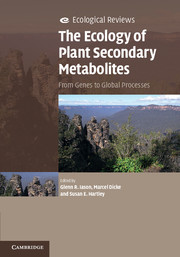Book contents
- Frontmatter
- Contents
- Contributors
- Preface
- Chapter One The integrative roles of plant secondary metabolites in natural systems
- Chapter Two Natural selection for anti-herbivore plant secondary metabolites
- Chapter Three Temporal changes in plant secondary metabolite production
- Chapter Four Mixtures of plant secondary metabolites
- Chapter Five The herbivore’s prescription
- Chapter Six Volatile isoprenoids and abiotic stresses
- Chapter Seven Atmospheric change, plant secondary metabolites and ecological interactions
- Chapter Eight The role of plant secondary metabolites in freshwater macrophyte–herbivore interactions
- Chapter Nine The soil microbial community and plant foliar defences against insects
- Chapter Ten Phytochemicals as mediators of aboveground–belowground interactions in plants
- Chapter Eleven Plant secondary metabolites and the interactions between plants and other organisms
- Chapter Twelve Integrating the effects of PSMs on vertebrate herbivores across spatial and temporal scales
- Chapter Thirteen Plant secondary metabolite polymorphisms and the extended chemical phenotype
- Chapter Fourteen From genes to ecosystems
- Chapter Fifteen Asking the ecosystem if herbivory-inducible plant volatiles (HIPVs) have defensive functions
- Chapter Sixteen Dynamics of plant secondary metabolites and consequences for food chains and community dynamics
- Index
- Plate Section
- References
Chapter Ten - Phytochemicals as mediators of aboveground–belowground interactions in plants
Published online by Cambridge University Press: 05 August 2012
- Frontmatter
- Contents
- Contributors
- Preface
- Chapter One The integrative roles of plant secondary metabolites in natural systems
- Chapter Two Natural selection for anti-herbivore plant secondary metabolites
- Chapter Three Temporal changes in plant secondary metabolite production
- Chapter Four Mixtures of plant secondary metabolites
- Chapter Five The herbivore’s prescription
- Chapter Six Volatile isoprenoids and abiotic stresses
- Chapter Seven Atmospheric change, plant secondary metabolites and ecological interactions
- Chapter Eight The role of plant secondary metabolites in freshwater macrophyte–herbivore interactions
- Chapter Nine The soil microbial community and plant foliar defences against insects
- Chapter Ten Phytochemicals as mediators of aboveground–belowground interactions in plants
- Chapter Eleven Plant secondary metabolites and the interactions between plants and other organisms
- Chapter Twelve Integrating the effects of PSMs on vertebrate herbivores across spatial and temporal scales
- Chapter Thirteen Plant secondary metabolite polymorphisms and the extended chemical phenotype
- Chapter Fourteen From genes to ecosystems
- Chapter Fifteen Asking the ecosystem if herbivory-inducible plant volatiles (HIPVs) have defensive functions
- Chapter Sixteen Dynamics of plant secondary metabolites and consequences for food chains and community dynamics
- Index
- Plate Section
- References
Summary
Introduction
Since Fraenkel (1959) put secondary plant compounds back on the research agenda for their role as mediators of plant–herbivore interactions, thousands of papers have been published on this topic. In the 150 years before Fraenkel’s paper, plant secondary metabolites (PSMs) were mainly analysed for medicinal purposes or for their application as textile dyes or spices (Hartmann, 2007). In those times, secondary metabolites were merely considered to be the waste products of the plant’s primary metabolism, despite the publication of an early monograph in the late nineteenth century on the role of plant metabolites as protection against snail damage (Stahl, 1888). In the past 50 years of research, we have finally come to acknowledge the fact that there may be ecological and evolutionary reasons for plants having become true ‘chemical factories’ (Gershenzon et al., Chapter 4). It is estimated that plants may produce over 200 000 different compounds, the majority of which are classified as secondary metabolites (Pichersky & Gang, 2000). Despite their name, secondary plant compounds have been found to fulfil essential functions in plant defence against herbivores and in attracting beneficial organisms, such as pollinators and symbionts (Harborne, 1993). Even within one single class of biosynthetically related compounds such as the terpenes, there may be an overwhelming variety of 30 000 structures (Hartmann, 2007). Based on the level of sequence homology in the genes coding for the biosynthetic enzymes producing this dazzling diversity of phytochemicals, it has been postulated that the diversity we observe today may have evolved from several rounds of single gene and whole genome duplications in the past (Maere et al., 2005). After these duplication events, the duplicated genes may have subfunctionalised and assumed slightly different biosynthetic functions, thereby increasing the diversity of plant secondary compounds (Mitchell-Olds & Clauss, 2002). Interestingly, it has been found that genes involved in the synthesis of secondary metabolites and responses to biotic stresses are more often retained than genes involved in hormonal signalling and primary metabolism (Maere et al., 2005). The differences in retention rates between genes in these different classes lend additional support to the hypothesis that the diversity of secondary metabolites represents an important adaptive trait which helps plants to survive in a world full of herbivores (Jones & Firn, 1991; Maere et al., 2005). Small variations in chemical structures may indeed have profound effects on herbivore performance, as was shown in Barbarea vulgaris plants.
- Type
- Chapter
- Information
- The Ecology of Plant Secondary MetabolitesFrom Genes to Global Processes, pp. 190 - 203Publisher: Cambridge University PressPrint publication year: 2012
References
- 3
- Cited by

